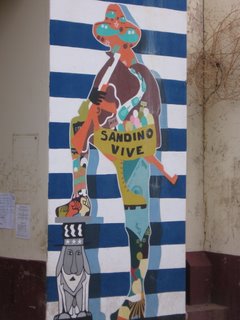
At the request of my friend Paul, here is a (somewhat) brief synopsis of the events leading to the Sandinista Revolution here in Nicaragua and a little of what has transpired since.
The story begins when a young Nica man named Augusto Cesar Sandino witnesses the US invasion of Nicaragua to sustain a failing Conservative government here by brutally crushing the Liberal rebellion. After spending a few years in Mexico, Sandino is inspired by the unionization efforts of workers there. He returns to Nicaragua and becomes a general for the Liberals, engaging in guerrilla warfare against the US installations in northern Nicaragua. In addition to his warfare strategies, Sandino formed agricultural coops of landless peasants, and fought on behalf of exploited workers. Finally the U.S. Marines left around the time of the Great Depression and Anastasio Somoza Garcia became president of Nicaragua. Somoza ordered Sandino shot, but Sandino's body was never found.
The installation of Somoza began a long and powerful family dynasty, under which power was centralized in the hands of a very few, elections were shams, and financial gain was limited to those within the dynasty. Somoza Garcia was well educated and has a successful relationship with U.S. Presidents, creating a lucrative trade relationship with the US at the expense of local natural resources and sustainable economic development. Somoza is remembered for several positive developments in Nicaragua too, including the construction of some public buildings, a railway, city water system, the airport, and the Pan-American Highway. Members of Somoza's family remained in power from 1937-1979.
In the 1960s, a student named Carlos Fonseca Amador revived the Sandino image and ideals to inspire a new political and guerilla movement which became known as the F.S.L.N. (Frente Sandinista de Liberacion Nacional). FSLN was initially supported by college students and city dwellers, but soon earned the loyalties of poor campesinos, and by 1979, had developed enough military strength to overthrow the dictatorship. After winning the war, FSLN had the tougher job of reorganizing the government and economy, a process which included the redistribution of thousands of acres of land and a massive literacy campaign, among other things.
From the beginning, FSLN encountered opposition, internally from the business community and externally from the world powers who were concerned about the Marxist tendencies of the new regime.The US began financing the Contras, former members of the Somoza national guard as well as campesinos unhappy with the FSLN's policies. By the end of the 1980s, the Sandinista government and the Contra war collapsed, and a Central American peace accord was reached. The agreement included pledges from all countries to permit full freedom for political parties and periodic elections (externally monitored).
For the last 15 years, while strongly contesting many elections as a legitimate political party, the Sandinistas have remained unable to retake the presidency, as members of other parties and coalitions have managed to defeat repeat FSLN candidate Daniel Ortega. Since the revolution, a “reformed Sandinista” party has also formed, known locally as MRS. MRS, FLSN, and two different Liberal coalitions have formed to vie for the presidency this year. It remains to be seen how the elections this November will turn out.
2 comments:
Thank you very much! I'd be interested in also hearing the ecclesio-political overtones — where was the believing Church through all of this? Was there a single Roman Catholic position (aligned with power, perhaps?), was there a liberación sub movement? Were protestants on the map at all? Curious. - pablo
Pam thanks for the history I too was curious
Post a Comment